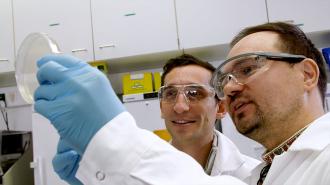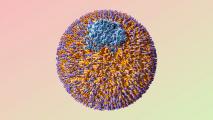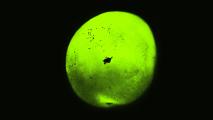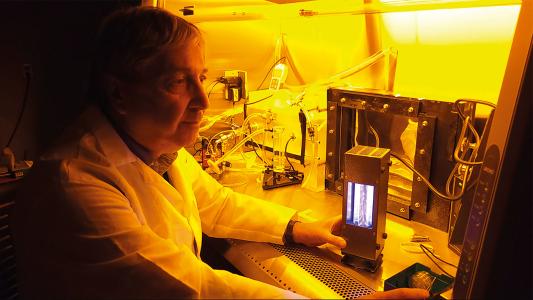This article is an installment of Future Explored, a weekly guide to world-changing technology. You can get stories like this one straight to your inbox every Thursday morning by subscribing here.
A unique CRISPR system that destroys infected cells is unlike anything scientists have ever seen before — and it could revolutionize how we use the powerful gene editing technology in the future.
CRISPR 101: While bacteria can infect humans, they can also be infected — a virus can inject its DNA in a bacterial cell and then use the cell like a virus factory, creating more and more copies of itself inside the cell until it bursts.
Just like we have an immune system to protect us against infections, some bacteria have a defense system called CRISPR.
CRISPR lets bacteria collect short DNA sequences from viruses it has seen before. Once it has a new DNA sequence, the CRISPR system creates CRISPR-associated (Cas) proteins, which contain copies of the sequence written in RNA.
There are several different Cas proteins, but the one we know the most about is Cas9. Once created, it will float around a cell, waiting for its target to try to infect the bacteria again.
If that happens, the RNA sequence in the Cas9 protein will bind to the matching sequence in the viral DNA and cut through both sides of its double helix. The sliced-up viral DNA can then be destroyed by other proteins in the bacteria — stopping the infection.
“It’s a phenomenon that elicits audible gasps from fellow scientists.”
Ryan Jackson
In 2012, scientists at Lawrence Berkeley National Laboratory published a paper showing that CRISPR could be used for genome editing. It turned out to be wildly successful, and not just in bacteria — if you correctly program CRISPR-Cas9, you can deactivate or remove genes in plants, animals, and even humans.
Since then, researchers have used CRISPR-Cas9 to treat diseases, create healthier crops, and more. They’ve also discovered and utilized CRISPR proteins beyond Cas9, such as Cas13, which cuts single-stranded RNA molecules rather than double-stranded DNA molecules.
What’s new? Now, researchers in the US and Germany have published two papers detailing a new CRISPR protein — Cas12a2 — which they say is more like a genetic Swiss Army Knife than a pair of scissors.
“With this new system … we’re seeing a structure and function unlike anything that’s been observed in CRISPR systems to date,” said researcher Ryan Jackson from Utah State University.
While other CRISPR systems bind to their target sequence, make their cut, and then stop, the researchers learned through a technique called “cryo-electron microscopy” that when Cas12a2 binds to its target, it seems to “activate,” transforming in shape.
“It’s a change in structure that’s extraordinary to observe — a phenomenon that elicits audible gasps from fellow scientists,” said Jackson.
Once activated, the protein can bind to any genetic material that comes near it, whether its single-stranded RNA, single-stranded DNA, or double-stranded DNA. Cas12a2 then starts shredding the material, making multiple cuts in indiscriminate locations.
Because the genetic material can belong to the bacteria itself, the result can be cellular death. Essentially, CRISPR causes the infected cell to self-destruct — rather than let it become a virus factory.
“It’s poor for that particular cell, but it protects the whole colony of bacteria so that virus doesn’t spread through it,” said Jackson.
If CRISPR-Cas12a2 is programmable, we might be able to use it to kill cells with cancerous mutations.
CRISPR vs. cancer: The newly published papers detail the structure and function of Cas12a2, but more research is needed to determine how we might be able to harness this system for our benefit.
The good news, so far, is that CRISPR-Cas12a2 looks programmable, meaning we might be able to use it to kill certain cells, such as those with cancerous mutations, while leaving healthy cells unharmed.
“If Cas12a2 could be harnessed to identify, target, and destroy cells at the genetic level, the potential therapeutic applications are significant,” said Jackson.
The future of tests: The protein also has potential as a diagnostic tool.
In the past, scientists have programmed CRISPR systems to produce detectable signals when they bind to specific viral sequences — if that signal is seen after adding the CRISPR tech to a sample of saliva, urine, or some other fluid, researchers know it contains the virus.
The problem is the CRISPR systems in those tests destroy the viral sequences after binding to them, which reduces the tests’ sensitivity, but by inserting a mutation into Cas12a2, researchers found that they could get it to only shred single-stranded DNA after activation.
“This could lead to a really sensitive diagnostic system.”
Jack Bravo
That means a test using Cas12a2 could produce a signal when the protein binds to the target sequence of an RNA virus — the type that causes flu, COVID-19, the common cold, and other infections — without destroying the viral RNA that activated it.
Because that RNA will still be there to activate other CRISPR proteins floating around, the signal will be boosted
“This could lead to a really sensitive diagnostic system, because we’re not depleting what we’re trying to find,” said researcher Jack Bravo from the University of Texas Austin.
“Today, we don’t have new continents to explore … but here in the molecular biosciences, it’s the new frontier.”
Ryan Jackson
In theory, such a diagnostic test would be highly accurate, like the PCR tests used for COVID-19 detection, but inexpensive and easy to use — like the less-sensitive but more convenient at-home COVID-19 tests.
Tests for new RNA viruses could also be easily produced as soon as we know their genomes.
Looking ahead: As exciting as that is, much more research is needed before we can start harnessing Cas12a2’s potential power as a diagnostic or therapeutic tool.
“We’re just scratching the surface, but we believe Cas12a2 could lead to improved and additional CRISPR technologies that will greatly benefit society,” said Jackson.
“Today, we don’t have new continents to explore or other things to discover in that way,” he added, “but here in the molecular biosciences, it’s the new frontier, and it’s a place where you can make really cool discoveries.”
We’d love to hear from you! If you have a comment about this article or if you have a tip for a future Freethink story, please email us at tips@freethink.com.






